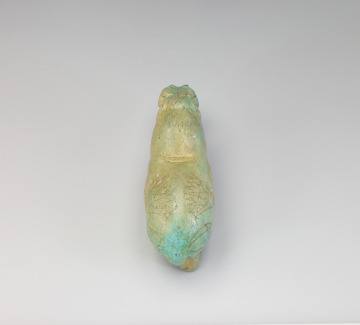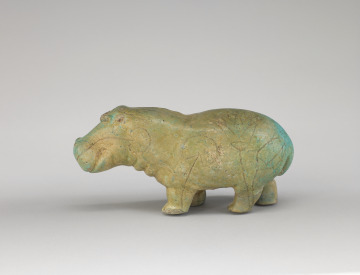Hippopotamus
- Artist Culture
- Egyptian
- Dynasty
- Dynasty 13, 1783–1650 BC
- Period
- Middle Kingdom, 2055–1650 BC
- Date
- 1783–1640 BC
- Material
- Faience
- Classification
- Sculpture
- Current Location
- On View, Gallery 313
- Dimensions
- 3 3/4 x 7 1/4 x 2 7/8 in. (9.5 x 18.4 x 7.3 cm)
- Credit Line
- Funds given by Martha I. Love
- Rights
- Contact Us
- Object Number
- 242:1952
NOTES
This figure of a hippo was molded in faience, a crushed quartz glazed and fired at a relatively low temperature. Copper salts in the glaze impart the bright blue or blue-green color so characteristic of faience objects. Over the animal's naturalistic shape, the craftsman painted lily plants that appear as a giant tattoo. Small sculptures of hippos such as this one were placed in tombs in ancient Egypt as reminders of the Egyptians' love of hunting. Each of the sculpted hippo's legs was ritually broken in order to render it harmless in the afterlife.
In ancient Egypt herds of hippos were a constant threat to farmers' fields. The first pharaohs hunted hippos in the marshes and eventually drove them far south into Upper Egypt. Hippos became associated with chaos, and the hunt for hippos became a metaphor for how the pharaohs of ancient Egypt could conquer evil.
Provenance
Maurice Nahman, Cairo, Egypt
by 1929 -
Comtesse de Behague, Paris, France, acquired from Maurice Nahman [1]
- 1952
Charles Ratton, Paris, France
1952 -
Saint Louis Art Museum, purchased from Charles Ratton [2]
Notes:
[1] In his 1929 publication, Ludwig Keimer notes that Behague acquired the piece from Nahman, but he did not record the date nor the method of transfer. He also said that all of the Hippos in the Nahman collection were from Matariji, discovered by Bedouin [Ludwig Keimer. "Revue de L'Égypte Ancienne." Paris: Libraire de la Société Francaise D'Égyptologie. 1929, Vol. II, p. 222, no. 9-10].
[2] See Invoice [undated, SLAM document files]. Minutes of the Administrative Board of Control of the City Art Museum, October 10, 1952.
by 1929 -
Comtesse de Behague, Paris, France, acquired from Maurice Nahman [1]
- 1952
Charles Ratton, Paris, France
1952 -
Saint Louis Art Museum, purchased from Charles Ratton [2]
Notes:
[1] In his 1929 publication, Ludwig Keimer notes that Behague acquired the piece from Nahman, but he did not record the date nor the method of transfer. He also said that all of the Hippos in the Nahman collection were from Matariji, discovered by Bedouin [Ludwig Keimer. "Revue de L'Égypte Ancienne." Paris: Libraire de la Société Francaise D'Égyptologie. 1929, Vol. II, p. 222, no. 9-10].
[2] See Invoice [undated, SLAM document files]. Minutes of the Administrative Board of Control of the City Art Museum, October 10, 1952.
Related Content
Pages
Audio Guide





